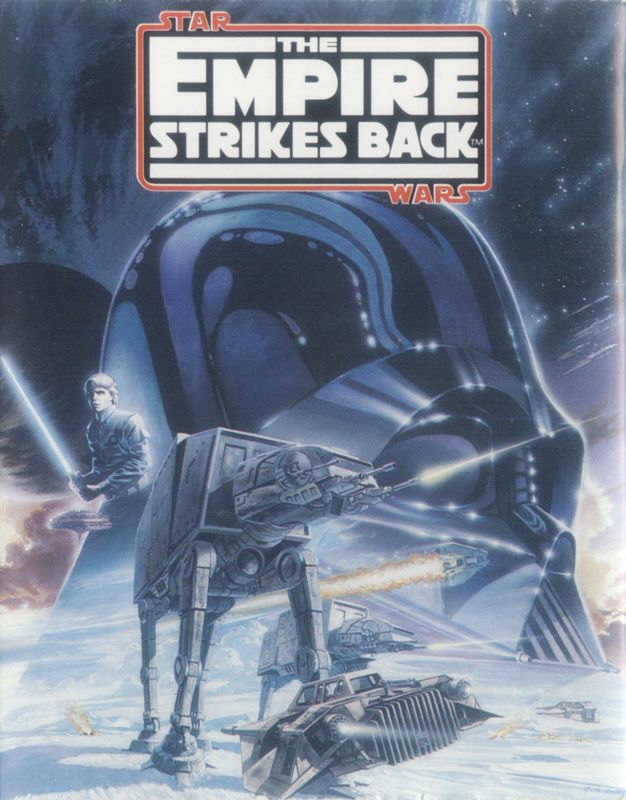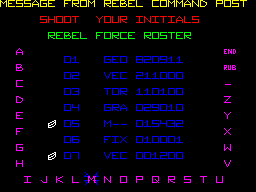Retro Replay Review
Gameplay
Star Wars: The Empire Strikes Back puts players in the cockpit of Rebel craft and the Millennium Falcon across four distinct, action-packed sequences. Each stage draws directly from iconic moments in the film, beginning on the icy surface of Hoth and ending with a nail-biting dash through an asteroid field. The transition between each sequence keeps the pace brisk, demanding players to adapt quickly to new objectives and enemy patterns.
In the first sequence, you pilot a snowspeeder over Hoth, tasked with destroying Imperial probe droids before they call in reinforcements. The droids emit transmissions that appear as small, flickering targets; prioritizing these adds a strategic layer to the high-speed dogfights. Once a set number of transmissions escape, you’re plunged into the next wave of action as the Empire’s forces close in.
The second sequence shifts focus to the Wampa-infested tundra, where you fend off towering AT-AT walkers. Your limited tow cables can trip the legs of these mechanical giants, while precise headshots with your lasers deal direct damage. The challenge here is balancing accurate shots with conserving your cable supply—miss too often, and the Rebel base’s generator will fall, triggering an urgent evacuation sequence.
Switching into space combat in the third sequence, you take control of the Millennium Falcon to dogfight TIE fighters. The challenge is not just picking off enemy ships, but doing so under a ticking clock before more Imperial reinforcements warp in. Finally, the fourth sequence puts your reflexes to the ultimate test as you weave the Falcon through a dense asteroid field, avoiding fast-moving rocks and debris.
After completing all four segments, the game loops back at a higher difficulty level, ensuring replay value for both casual fans and hardcore arcade veterans. This escalating challenge makes the experience addictive, encouraging players to improve their reflexes, target prioritization, and overall strategy with each run.
Graphics
Atari’s choice to use crisp vector graphics gives The Empire Strikes Back a distinctive, retro-futuristic look. Much like its predecessor, the first Star Wars arcade game, the use of glowing wireframe models and stark backgrounds creates an immersive, first-person perspective that feels both minimalistic and highly responsive. This style allows each object—be it a probe droid, AT-AT walker, or asteroid—to stand out clearly in the heat of battle.
The simplicity of the vector lines belies the visual clarity they provide. In the Hoth sequences, you can instantly recognize the outline of an incoming probe droid, while in space, the angular silhouettes of TIE fighters cut sharply against the void. There’s no busy texture work to distract you; everything you see serves a gameplay purpose, helping you focus on your next move.
Color is used sparingly but effectively. Green reticles for targeting, red flashes on successful hits, and the occasional amber transmission icon give you crucial visual feedback. The black backgrounds simulate the depths of space or the empty arctic wasteland, allowing the bright vectors to pop in stark contrast. This approach may seem simplistic by modern standards, but it delivers a clean, legible battlefield even when the action heats up.
On the arcade cabinet’s vector monitor, the game’s graphics possess a unique glow and flicker that enhance the nostalgic charm. Each laser blast and explosion is represented by quick, bright lines that linger just a moment before vanishing—a satisfying flourish that hammers home every victory and near-miss.
Overall, while The Empire Strikes Back won’t compete with today’s polygon-based visuals, its vector aesthetic remains timeless. It’s a shining example of how effective, stylized graphics can elevate an arcade shooter and keep players coming back for more.
Story
Although primarily an action-focused arcade game, Star Wars: The Empire Strikes Back weaves its narrative through stage design and brief on-screen prompts. By structuring each sequence around pivotal film moments—from the Rebel defense on Hoth to the perilous escape through the asteroid field—the game captures the essence of the movie without lengthy cutscenes or text.
The narrative flow is conveyed through your objectives. In the first level, the urgency to destroy probe droids reflects the looming Imperial threat; in the second, the desperation of defending the Rebel base. Each mission feels like your own contribution to the larger galactic conflict, even if the storytelling is minimalist compared to modern titles.
Despite the lack of voiced dialogue or character development, the game’s faithful recreation of cinematic scenarios provides enough context for Star Wars fans. You know exactly why you’re blasting walkers on Hoth or dodging asteroids—each sequence propels you deeper into the Empire’s relentless pursuit of the Rebel Alliance.
This streamlined approach to story suits the arcade format perfectly. You jump in, play through a series of high-stakes encounters, and experience the thrill of key movie moments in a distilled, fast-paced form. For many players, this direct connection to the beloved film is more than enough narrative motivation.
In the end, the game’s story functions as a framework for its action. It offers just enough context to feel authentic to the Star Wars universe while leaving the spotlight on the core gameplay sequences that define the arcade experience.
Overall Experience
Star Wars: The Empire Strikes Back for the arcade embodies the best of early-’80s coin-op design: immediate, intense, and endlessly replayable. With four varied sequences that capture the spirit of the film, the game offers a compact yet thrilling journey through the Empire’s most famous encounters.
The difficulty curve is steep but fair—perfect for arcade veterans chasing high scores. The escalating challenge as you loop back through the levels keeps you on your toes, demanding finer target prioritization and split-second reflexes with each repeat play. This blend of simple controls and intricate gameplay loops creates a highly addictive formula.
Nostalgia plays a big part in the game’s appeal. The whine of vector lines, the satisfying “pew-pew” sound effects, and the bright, spartan visuals all transport players back to the golden age of arcade gaming. Yet even for newcomers, the game’s clear objectives and responsive mechanics make it approachable and fun.
While it lacks the narrative depth and graphical fidelity of modern Star Wars titles, The Empire Strikes Back succeeds on its own terms. It distills four hallmark scenes into bite-sized challenges that reward precision and perseverance. Whether you’re a lifelong fan of the franchise or a retro arcade enthusiast, this game delivers a compact, exhilarating slice of Star Wars history.
In conclusion, Atari’s Empire Strikes Back arcade game remains a must-play for anyone seeking fast-paced action backed by iconic source material. Its blend of vector visuals, faithful movie scenarios, and escalating difficulty creates a timeless experience that still shines under the neon glow of an arcade cabinet.
 Retro Replay Retro Replay gaming reviews, news, emulation, geek stuff and more!
Retro Replay Retro Replay gaming reviews, news, emulation, geek stuff and more!









Reviews
There are no reviews yet.